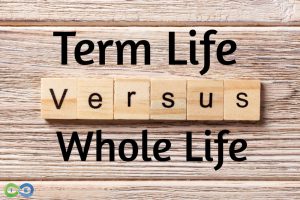When it comes to purchasing life insurance, one of the first decisions you’ll need to make is whether to choose term life insurance or whole life insurance. Both types of policies have distinct advantages and serve different purposes, so understanding the differences between them is key to selecting the right option for your financial needs and goals. In this article, we will explore the characteristics, benefits, and considerations of term and whole life insurance to help you determine which is best for you.
What is Term Life Insurance?
Term life insurance is the most straightforward and affordable type of life insurance. It provides coverage for a specific period, known as the “term,” which typically lasts between 10 to 30 years. If you pass away during the term of the policy, your beneficiaries receive the death benefit. However, if the policy term expires and you are still alive, the coverage ends with no payout. Term life insurance is often chosen by those who need coverage for a set period, such as while raising children or paying off a mortgage.
What is Whole Life Insurance?
Whole life insurance, a type of permanent life insurance, provides lifelong coverage as long as you continue to pay your premiums. Unlike term life insurance, whole life insurance policies also have a savings component, known as “cash value.” The cash value accumulates over time, earning interest, and can be accessed through loans or withdrawals. Whole life insurance is more expensive than term life insurance, but it offers lifelong protection and the opportunity to accumulate savings that can be used during your lifetime.
Key Differences Between Term and Whole Life Insurance
- Duration of Coverage
The most obvious difference between term and whole life insurance is the duration of coverage. Term life insurance is temporary, covering you for a fixed number of years, whereas whole life insurance provides coverage for your entire lifetime. If you only need coverage for a specific period, such as until your children are financially independent, term life may be the better option. On the other hand, if you want permanent coverage and lifelong protection for your loved ones, whole life insurance is the way to go. - Cost of Premiums
One of the primary advantages of term life insurance is its affordability. Premiums for term life insurance are generally much lower than whole life premiums, making it an attractive option for those on a budget or who want to maximize their coverage while minimizing costs. Whole life insurance, however, comes with higher premiums due to its lifelong coverage and cash value component. While this can be more expensive upfront, the policy may provide long-term benefits, including the ability to build wealth through cash value accumulation. - Cash Value Component
Whole life insurance policies come with a cash value component, which is essentially a savings account within the policy. A portion of your premiums goes toward building this cash value, which grows over time. You can borrow against or withdraw the cash value during your lifetime, providing you with a source of funds if needed. In contrast, term life insurance has no cash value. The premiums you pay go entirely toward providing the death benefit, with no accumulation of savings or investment value. - Flexibility
Term life insurance is straightforward and easy to understand. You pay a fixed premium for the duration of the policy, and if you pass away during the term, your beneficiaries receive the death benefit. There are no complicated investment components or additional riders to consider. Whole life insurance, however, offers more flexibility, particularly through its cash value feature. You can adjust the death benefit or premium payments (within certain limits), and the policy can serve as an investment vehicle for wealth accumulation. However, this added complexity may require more attention and understanding. - Renewability and Convertibility
Term life insurance policies can often be renewed at the end of the term, but the premiums will increase significantly as you age. Some term policies also offer a conversion option, allowing you to convert your term policy into a whole life policy without undergoing a medical exam. Whole life insurance, on the other hand, does not require renewals since it is permanent coverage. Once you have purchased a whole life policy, you are guaranteed coverage for life as long as premiums are paid.
Who Should Consider Term Life Insurance?
Term life insurance is ideal for individuals who need affordable coverage for a specific period. If you have young children, a mortgage, or other temporary financial obligations, term life insurance can provide a sufficient death benefit to protect your family during those critical years. Term life is also a good option if you want to maximize coverage without breaking your budget. Those who are generally in good health and do not require permanent coverage may find term life insurance to be the most practical and cost-effective choice.
Who Should Consider Whole Life Insurance?
Whole life insurance is best suited for those who want lifelong coverage and the ability to accumulate wealth through the policy’s cash value. If you are looking for a policy that offers both insurance protection and an investment component, whole life insurance may be a good fit. It is also suitable for individuals who wish to leave a legacy or provide for their beneficiaries in the long term. Whole life insurance can serve as a valuable estate planning tool, allowing you to pass on wealth to heirs or a charitable organization.
Pros and Cons of Term Life Insurance
Pros
- Affordable premiums
- Simple and easy to understand
- Provides high coverage for a specific term
- Ideal for those with temporary financial obligations
Cons
- Coverage ends when the term expires
- No cash value accumulation
- Premiums increase if you renew the policy after the term ends
Pros and Cons of Whole Life Insurance
Pros
- Lifelong coverage
- Builds cash value over time
- Can serve as a wealth-building tool
- Fixed premiums that do not increase with age
Cons
- Higher premiums compared to term life
- Complex policy structure
- Cash value may take years to grow substantially
How to Decide Which Is Right for You
Deciding between term and whole life insurance ultimately depends on your financial goals, needs, and budget. If you need affordable coverage for a specific period, such as until your children are grown or your mortgage is paid off, term life insurance is likely the best option. However, if you want to ensure lifelong coverage and have the ability to accumulate savings through a cash value component, whole life insurance may be worth the higher premiums.
It’s also important to consider your long-term financial plan and consult with a financial advisor or insurance agent who can help you evaluate your options. Whether you choose term life insurance or whole life insurance, the most important step is to get the coverage you need to protect your loved ones and secure your financial future.
Conclusion
Term and whole life insurance each offer unique benefits and drawbacks. Term life insurance is ideal for individuals who need affordable coverage for a set period, while whole life insurance is better for those seeking permanent coverage with the added benefit of cash value accumulation. By understanding the key differences between these two types of policies, you can make an informed decision that aligns with your financial goals and provides the right protection for your loved ones.



